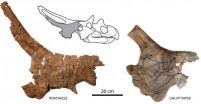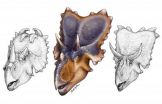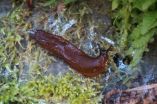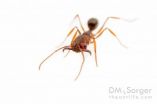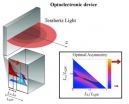(Press-News.org) Cleveland, Ohio - Scientists have named a new species of horned dinosaur (ceratopsian) based on fossils collected from Montana in the United States and Alberta, Canada. Mercuriceratops (mer-cure-E-sare-ah-tops) gemini was approximately 6 meters (20 feet) long and weighed more than 2 tons. It lived about 77 million years ago during the Late Cretaceous Period. Research describing the new species is published online in the journal Naturwissenschaften.
Mercuriceratops (Mercuri + ceratops) means "Mercury horned-face," referring to the wing-like ornamentation on its head that resembles the wings on the helmet of the Roman god, Mercury. The name "gemini" refers to the almost identical twin specimens found in north central Montana and the UNESCO World Heritage Site, Dinosaur Provincial Park, in Alberta, Canada. Mercuriceratops had a parrot-like beak and probably had two long brow horns above its eyes. It was a plant-eating dinosaur.
"Mercuriceratops took a unique evolutionary path that shaped the large frill on the back of its skull into protruding wings like the decorative fins on classic 1950s cars. It definitively would have stood out from the herd during the Late Cretaceous," said lead author Dr. Michael Ryan, curator of vertebrate paleontology at The Cleveland Museum of Natural History. "Horned dinosaurs in North America used their elaborate skull ornamentation to identify each other and to attract mates—not just for protection from predators. The wing-like protrusions on the sides of its frill may have offered male Mercuriceratops a competitive advantage in attracting mates."
"The butterfly-shaped frill, or neck shield, of Mercuriceratops is unlike anything we have seen before," said co-author Dr. David Evans, curator of vertebrate palaeontology at the Royal Ontario Museum. "Mercuriceratops shows that evolution gave rise to much greater variation in horned dinosaur headgear than we had previously suspected."
The new dinosaur is described from skull fragments from two individuals collected from the Judith River Formation of Montana and the Dinosaur Park Formation of Alberta. The Montana specimen was originally collected on private land and acquired by the Royal Ontario Museum. The Alberta specimen was collected by Susan Owen-Kagen, a preparator in Dr. Philip Currie's lab at the University of Alberta. "Susan showed me her specimen during one of my trips to Alberta," said Ryan. "When I saw it, I instantly recognized it as being from the same type of dinosaur that the Royal Ontario Museum had from Montana."
The Alberta specimen confirmed that the fossil from Montana was not a pathological specimen, nor had it somehow been distorted during the process of fossilization," said Dr. Philip Currie, professor and Canada research chair in dinosaur paleobiology at the University of Alberta. "The two fossils—squamosal bones from the side of the frill—have all the features you would expect, just presented in a unique shape."
"This discovery of a previously unknown species in relatively well-studied rocks underscores that we still have many more new species of dinosaurs to left to find," said co-author Dr. Mark Loewen, research associate at the Natural History Museum of Utah.
This dinosaur is just the latest in a series of new finds being made by Ryan and Evans as part of their Southern Alberta Dinosaur Project, which is designed to fill in gaps in our knowledge of Late Cretaceous dinosaurs and study their evolution. This project focuses on the paleontology of some of oldest dinosaur-bearing rocks in Alberta and the neighbouring rocks of northern Montana that are of the same age.
INFORMATION:
Full Reference: Michael J. Ryan, David C. Evans, Philip J. Currie, and Mark A. Loewen. 2014. "A new chasmosaurine from northern Laramidia expands frill disparity in ceratopsid dinosaurs"
DOI 10.1007/s00114-014-1183-1
Press images: https://www.cmnh.org/Mercuriceratops
Media Contact:
Glenda Bogar
Cleveland Museum of Natural History
216-231-2071
gbogar@cmnh.org
Media Contact:
Wendy Vincent
Royal Ontario Museum
416-586-5547
wendyv@rom.on.ca
Media Contact:
Sandra Robertson
University of Alberta
780-492-6226
sandra.robertson@ualberta.ca
Media Contact:
Patti Carpenter
Natural History Museum of Utah
801-585-6369
pcarpenter@nhmu.utah.edu
About the Cleveland Museum of Natural History
The Cleveland Museum of Natural History, incorporated in 1920, is one of the finest institutions of its kind in North America. It is noted for its collections, research, educational programs and exhibits. The collections encompass more than 5 million artifacts and specimens, and research of global significance focuses on 11 natural science disciplines. The Museum conserves biological diversity through the protection of more than 6,000 acres of natural areas. It promotes health education with local programs and distance learning that extends across the globe. Its GreenCityBlueLake Institute is a center of thought and practice for the design of green and sustainable cities.
About the Royal Ontario Museum
Opened in 1914, Canada's largest museum of natural history and world cultures has six million objects in its collections and galleries showcasing art, archaeology and natural science. The ROM is the largest field research institution in the country, and a world leader in research areas from biodiversity, palaeontology, and earth sciences to archaeology, ethnology and visual culture—originating new information towards a global understanding of historical and modern change in culture and environment. For 24-hour information in English and French, please call 416.586.8000 or visit the ROM's web site at http://www.rom.on.ca. Tickets are available online at http://www.rom.on.ca. For specific questions or concerns pertaining to the ROM's Accessibility, call 416.586.8000 prior to visiting. For those who are deaf, deafened or hard of hearing, Bell Relay Service can be reached by dialing 711 or 1.800.855.0511.
About the University of Alberta
The University of Alberta in Edmonton is one of Canada's top teaching and research universities, with an international reputation for excellence across the humanities, sciences, creative arts, business, engineering, and health sciences. Home to more than 39,000 students and 15,000 faculty and staff, the university has an annual budget of $1.7 billion and attracts nearly $450 million in sponsored research revenue. The U of A offers close to 400 rigorous undergraduate, graduate, and professional programs in 18 faculties on five campuses—including one rural and one francophone campus. The university has almost 250,000 alumni worldwide. The university and its people remain dedicated to the promise made in 1908 by founding president Henry Marshall Tory that knowledge shall be used for "uplifting the whole people."
About the Natural History Museum of Utah
The Natural History Museum of Utah, the University of Utah, is one of the leading scientific research and cultural institutions in the Intermountain West. Established in 1963, the Museum cares for over 1.2 million objects and offers innovative exhibitions and educational programs to thousands of residents and visitors each year, including traveling and permanent exhibits, special events and other programs. The Museum also offers a variety of outreach programs to communities and schools throughout Utah, reaching every school district in the state annually. The Museum has an active research program with more than 30 scientists and 10 field expeditions each year.
New horned dinosaur reveals unique wing-shaped headgear
2014-06-18
ELSE PRESS RELEASES FROM THIS DATE:
Spanish slug -- Busting an invasion myth
2014-06-18
Frankfurt am Main, Germany, June 18th 2014. Spanish slugs (Arion lusitanicus) are one of the most common slug species in Central Europe. The animals sometimes nicknamed "killer slugs" are known to do their fair share of damage in fields and gardens. The slug was thought to have originated in Southern Europe. However researchers of the German Biodiversity and Climate Centre and the Goethe University now found out, that the prime example of an invasive species is originally from Central Europe and thus no "immigrant" after all. Control measures, such as the EU regulation ...
New study is first to identify, clarify MERS-related abnormality distribution on CT
2014-06-18
Leesburg, VA, June 18, 2014—Researchers in Saudi Arabia have identified key defining characteristics of Middle East Respiratory Syndrome (MERS) in CT imaging of patients confirmed as having the disease.
The study found that the most common CT finding in hospitalized patients with MERS infection is suggestive of an organizing pneumonia pattern.
"A few studies have described variable degrees of lung opacities in patients with MERS, but did not clearly address their exact distribution," said Amr M. Ajlan, the corresponding author of the study. "Because we evaluated the ...
Study shows cost-effectiveness of smoking cessation counseling during hospitalization
2014-06-18
OTTAWA, June 18, 2014 – In a recent study published in Tobacco Control, researchers at the University of Ottawa Heart Institute have demonstrated the cost-effectiveness of the Ottawa Model for Smoking Cessation (OMSC), an intervention that includes in-hospital counseling, pharmacotherapy and post-hospital follow-up, compared to usual care among smokers hospitalized with acute myocardial infarction, unstable angina, heart failure, and chronic obstructive pulmonary disease.
The study examined patients hospitalized in Ontario, a province with a population of approximately ...
Animals conceal sickness symptoms in certain social situations
2014-06-18
The review's sole author, Dr. Patricia Lopes from the Institute of Evolutionary Biology and Environmental Studies at the University of Zurich, says that animals from a number of different species will eat and drink less, reduce their activity and sleep more when they are sick in order to conserve energy for their recovery. However, this can all change depending on the social situation.
In a paper published this week in the journal Proceedings of the Royal Society B, Lopes reviewed a range of different social situations that affected the behavior of sick animals, including ...
Childhood maltreatment associated with cerebral grey matter abnormalities
2014-06-18
An international study has analysed the association between childhood maltreatment and the volume of cerebral grey matter, responsible for processing information. The results revealed a significant deficit in various late developing regions of the brain after abuse.
According to the World Health Organisation (WHO), child maltreatment is defined as all forms of physical and/or emotional ill-treatment, sexual abuse, neglect or negligent treatment or commercial or other exploitation, resulting in actual or potential harm to the child's health, survival, development or dignity ...
Trap-jaw ants spreading in southeastern United States
2014-06-18
Trap-jaw ant species are active hunters with venomous stings and jaws powerful enough to fling themselves through the air. According to new research, they are also spreading into new territory in the southeastern United States. The research was done by scientists at North Carolina State University, the Mississippi Entomological Museum, the University of California, Davis and Archbold Biological Station.
"The fact that some of these species are spreading is interesting, in part, because these giant ants have managed to expand their territory without anyone noticing," says ...
Scientists about sequencing data: We drown in data but thirst for knowledge
2014-06-18
While more and more genomic information is becoming available at a drastically increasing pace, the knowledge we can gain about how microorganisms interact with their surrounding, infect hosts and alter their molecular programs in accordance to changing environmental conditions remains widely not deducible from genomic data alone, the researchers from University of Southern Denmark claim. This raises questions regarding the value of newly sequenced species.
The researchers have analyzed the genomes that are available from the past 20 years of sequencing bacterial DNA. ...
Horizontal levitation: The ultimate solution to particle separation
2014-06-18
Magnetic separators exploit the difference in magnetic properties between minerals, for example when separating magnetite from quartz. But this exercise becomes considerably more complex when the particles are not magnetic. In the wake of previous particle levitation experiments under high-power magnetic fields, a new study reveals that particles are deflected away from the magnet's round-shaped bore centre in a horizontal direction. Previous studies had observed the vertical levitation of the particles. These findings are presented by Shixiao Liu from the Faculty of Engineering, ...
New quantum mechanism to trigger the emission of tunable light at terahertz frequencies
2014-06-18
Scientists have found that two-dimensional (2D) nanostructures with asymmetric design enable a new quantum mechanism, triggering the emission of tunable light at terahertz frequencies—with unprecedented efficiency.
The researchers, from the University of Southampton and Imperial College London, found that quantum wells, 2D nanostructures formed of several layers of semi-conductor alloys placed on top of each other like a sandwich, can enhance light emission in a technological challenging spectral range.
It is hoped that the findings will have an impact on photonic ...
Only 16 percent of Ph.D.s work in the private sector in Spain, half the OECD average
2014-06-18
This news release is available in Spanish.
The report explains that Ph.D.s who work as researchers represent, on average in the OECD, 68.6% of those who are employed. By institutional sectors, the percentages of employees who work as researchers break down as follows: 45.4% in the private sector, 70.8% in public administration and 75.9% in higher education. In Spain, 86% of Ph.D.s employed in higher education are researchers, while for the private sector, this figure is only 26.5%.
According to OECD figures, leading innovative countries like the United States, ...

